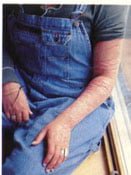All names* have been changed for privacyPersonal Accounts
“Through high school, concealer was my best friend,” says Marissa* about trying to hide her scars.
Marissa is one of the many students that have had problems with self-injury. She used to use exacto knives, razorblades, and even staples to mutilate herself. “I thought I was pretty creative, but then I realized it was just sad,” she said.
The story of someone cutting themselves may sound outlandish and strange to some, but to others it has a more familiar face. Self-mutilation and self-injury have been more noticeable in the community in recent years. Support centers and groups have been established specifically to treat people with the chronic habit of self-injury.
National awareness of the problem has given victims the psychiatric attention they need, and now the media is addressing this once-taboo subject as well. In fact, the issue now has its own day to make people more aware of the problem. March 1, 2002, was National Self-Injury Awareness Day.
When people injure themselves, they are not necessarily trying to commit suicide. They are using self-mutilation as a kind of therapy to get themselves through life. “I don’t feel guilty about it at all. It’s something that got me through an annoying and unfriendly part of my life,” says Luther*.
Luther has been cutting himself since he was 14. Although he has not done it often in the past year, he used to use such items as scalpels, surgical lancets, knives, obsidian shards, cigarettes, and needles to injure his forearms. “Pain and pleasure are different faces of the same coin. Feeling something is better than feeling nothing,” he says.
Self-injurers may resort to injury only under great pressure. However, this behavior can easily become a habit, as it offers an outlet for emotional stress. Some students can take control over their urges with enough determination.
Rosalyn* says, after she has injured herself, “sometimes I’m kinda horrified, but most of the time pretty relaxed.” Although Rosalyn has only cut herself twice since being on campus, she says she “.made the decision to take control of it. If I hadn’t, I would’ve ended up doing it more.”
There are many reasons why people resort to physically injuring themselves. “Somehow having a physical outlet for the emotional pain you are feeling is good,” says Alice,* of her explaining her self-injury. “For me it was useful. I definitely needed it, but, at the same time, it was unhealthy.”
A Clinical View
Catherine Kannenberg, chair of the psychology department, cites self-injury as one criterion for Borderline Personality Disorder. Aspects of this disorder include impulsivity, disassociative experiences, and chronic feelings of emptiness, and abandonment issues.
People that have Borderline Personality Disorder use self-mutilation to make themselves feel real. Their mind is in a different reality than their body, and often self-injury snaps them back into place. “It’s self-stimulation that happens to be self-destructive,” says Kannenberg, adding that “it makes them feel alive, real, and brings them back from a disassociative state.”
An abnormal psychology textbook by Barlow and Durand says, “these people are sometimes described as chronically bored.”
This leads to another explanation for self-mutilation. Most people that self-injure do not actually have Borderline Personality Disorder. Instead, it is just a tool for them to handle the trials of a chaotic lifestyle.
The Diagnostic and Statistical Manual of Mental Disorders (DSM-IV) published by the American Psychiatric Association explains, “adolescents and young adults with identity problems (especially when accompanied by substance abuse) may transiently display behaviors that misleadingly give the impression of Borderline Personality Disorder. Such situations are characterized by emotional instability, ‘existential’ dilemmas, uncertainty, anxiety-provoking choices, conflicts about sexual orientation, and competing social pressures to decide on careers.” This statement reflects the type of atmosphere in many colleges in the United States.
Ernest McCoy, the Director of Counseling Services on campus for the last 16 years, is hesitant about putting a label on people who self-injure. Instead, he says the source of this behavior is “emotional pain.”
“The process of self-abuse is to deal with the pain one is experiencing,” McCoy says. He also points out that self-abuse does not necessarily have to involve mutilation. Alcohol and drug abuse and sexual promiscuity can also be forms of self-injury.
Trend or Old Problem?
“I’ve always had a certain number of cases every year,” McCoy says, indicating that this is not a new problem. According to the DSM-IV, almost 75% of people that cut themselves are women between 15 and 30. He has witnessed this trend on campus, as most of the patients he has treated for self-mutilation have been women.
However, Kannenberg also wonders if some self-mutilation occurs because of peer influence. “It may diffuse through a group through social contagion, especially in a population going through an adjustment.” A huge adjustment, such as entering college life, could certainly cause a rise in self-injury cases. Vulnerable individuals facing a tough time may see this type of behavior in a friend and emulate it.
McCoy takes the position that self-injury is not just a problem of the 21st century but has always been around. “The community has become more accepting of talking about it – not accepting the cutting itself, but the talking about it.”
Where to Find Help
In fact, in the first semester of the 2001-2002 school year there was a support group called HUSH to help students to deal with self-injury. While it is not functioning now, the Health Center is still the best place to go if someone needs help and support.

